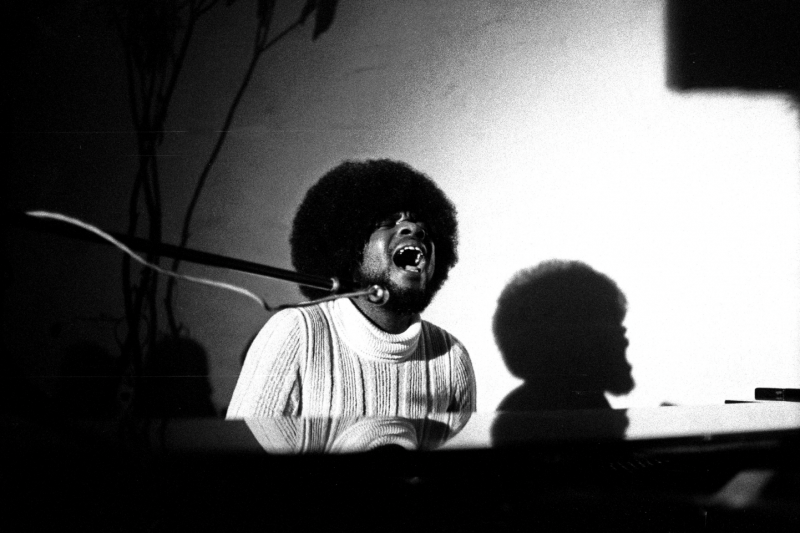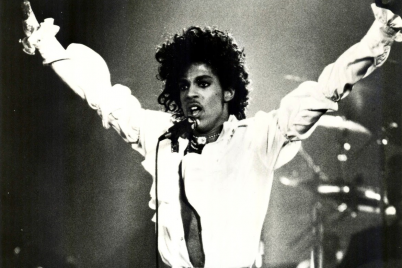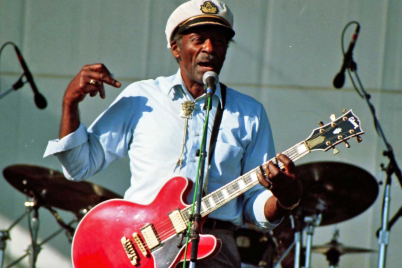Billy Preston singing at the piano in 1971.
BY FRANK DROUZAS | Staff Writer
Howlin’ Wolf electrifies an audience on “Shindig!”
With his booming Mississippi voice and bulky 6’ 3” frame, Chester Arthur Burnett — alias Howlin’ Wolf — exuded a confident, don’t-mess-with-me presence when he performed on the musical variety TV show “Shindig!” in 1965.
Accompanied by the backing band’s driving piano and mournful guitar, the gravelly-voiced Howlin’ Wolf stabbed at the air defiantly as he belted out “How Many More Years,” a song about moving on. He even made his harmonica wail full force, unleashing the unmistakable power of the blues and showing that it could be just as electrifying as rock and roll.
Helping the show’s host introduce the African-American bluesman were Mick Jagger and Brian Jones of the Rolling Stones, who made no bones about the fact that Howlin’ Wolf was one of their biggest idols. The scruffy-haired, authority-flouting English rockers were reduced to giddy, grinning schoolboys when talking about the elder blues statesman. In fact, when the host brought up the Stones’ recent straight-up blues hit “Little Red Rooster,” Jagger had to clue him in that it was Howlin’ Wolf who had recorded it first. A minute later an impatient Jones told the blabbering host it was time he shut up so Howlin’ Wolf could perform!
Though Howlin’ Wolf had fans of his own—having recorded at Sun Studio in Memphis, Tenn., and released a string of Chess Records classics—this charged performance effectively kicked down the door of many American living rooms to show a whole new TV audience where the very roots of rock and roll were.
Chuck Berry revs up “Maybelline”
With its perfect combination of sped-up country lilt, raw rhythm and blues and witty, adolescent poetry “Maybelline” became a blueprint of rock and roll songs for decades to come.
Arthur Lee and Love release ‘Forever Changes’
One of the first racially diverse bands, Los Angeles-based outfit Love was fronted by African-American singer-songwriter Arthur Lee. The group came to prominence in the mid-1960s on the strength of its self-titled debut and the follow-up album “Da Capo,” but the band’s third studio album “Forever Changes,” lauded by music critics upon its 1967 release, is now considered the band’s masterpiece.
Co-produced by multi-instrumentalist Lee, the album consists of a wide-ranging sound as the band threw brass, mariachi trumpets and even a string orchestra into the heady mix. Though trippy electric guitars make an appearance, the record derives its strength from the layered acoustic instruments interwoven with the delicately melodic orchestration.
A big reason why this record stands apart from the incense-and-peppermint taste of the Summer of Love is Lee himself, as his biting, meaningful lyrics reflect a darker side of the hippie era. A black artist in a folk-psychedelic scene that was almost the exclusive domain of white musicians, Lee was uniquely in touch with the cultural climate of America as themes of race and human relationships appear in his hard-hitting songs.
In “The Red Telephone,” he sings, “Sometimes my life is so eerie/And if you think I’m happy/Paint me white (yellow).” The powerful “Bummer In The Summer” features the lines “It’s really hard to learn/That everyone I saw was just another part of me.”
Though the record barely caused a ripple on the charts when first released, it is now frequently included in prestigious lists of rock’s greatest albums by such authorities as Rolling Stone magazine and the New Musical Express, and was inducted into the Grammy Hall of Fame in 2008. “Forever Changes” has influenced and been admired by generations of acts, including Led Zeppelin’s vocalist Robert Plant, the Stone Roses and even seminal punk band the Damned.
Billy Preston lends a hand (or two) to the Beatles
By 1969 when the Beatles went into the studio to record “Let It Be,” disagreements and rising tensions among the members were pushing them to the brink of breaking up. Guitarist George Harrison brought in Preston not only to play on the album but to help relieve some of the turmoil surrounding the band.
Preston played electric piano and Hammond organ on several of the tracks, but his distinctive, energetic work on the up-tempo “Get Back” helps make it one of the album’s brightest spots. Reaching number one around the world, the single even notched the young African-American musician a co-credit since it was billed as “The Beatles with Billy Preston,” making it the revered band’s only single that credited another artist.
John Lennon felt the American keyboardist was such a good fit that at one point during the sessions he proposed making him a full-fledged member of the band. This idea was quickly shot down by Paul McCartney, stating that things were difficult enough to agree upon with only four members. The group did, however, bring Preston along to perform with them at their famous rooftop concert above the Apple Studio headquarters while they were filming the making of the album. That impromptu concert on Jan. 30, 1969, turned out to be the final public performance of arguably the greatest band ever — and Preston was a part of it.
Prince steals the show with his guitar solo
During an all-star jam at the 2004 Rock and Roll Hall of Fame induction ceremonies, the band assembled onstage was performing the Beatles’ classic “While My Guitar Gently Weeps.” The firepower included such rock heavyweights as ELO’s Jeff Lynne, Tom Petty, Steve Winwood and Prince, who was an inductee that year. As the song headed toward its close, the Purple One decided to take things into his own talented hands. Donned in a dark suit with a crimson-colored shirt and brazenly crimson fedora to match, Prince emerged from the dark shadow at the far side of the stage and stepped into the light to unleash one of the most exciting guitar solos in rock history.
Now a solo played by Prince Rogers Nelson is an experience—for anyone watching him perform and for the artist himself. His interpretive body language and emotional expressions are not artificial rock posturing or mere theatrics but 100 percent genuine, as he injects feeling into the music he plays like nobody’s business. And on this night His Royal Badness delivered an especially transcendental performance, infusing life into every note that came moaning and screaming from his Hohner Telecaster. Fingering the fret board with a sensuality, which only Prince can exhibit, at one moment he caressed the instrument — almost fondling it — while at another he hammered away at the chords with a fierce, lustful energy. On that night he truly made his mournful guitar weep.
Not that scripted theatrics were altogether abandoned. At one point in the middle of his solo, Prince turned to face the band and leaned so far back on his heels that a beefy hired hand stepped dutifully forward to not only support him so he wouldn’t fall off the stage but to push him back upright onto the stage again — and through all this Prince never missed a single note! After a pause to grin impishly at his stage mates who apparently had little idea of what he was going to do next, the High Priest of Pop cranked up the emotion again, stooping down to unleash some blistering fretwork before straightening up to coax out some long, wailing notes by plucking at his strings with elaborate arm movements.
For his coup de grace, he capped this six-string shredfest with some screeching notes and then — proving he is a born showman like few others — unstrapped his guitar and flung it irreverently off the stage before sauntering away, leaving behind him the rest of the illustrious musicians and more than a few astounded people in the select audience.








